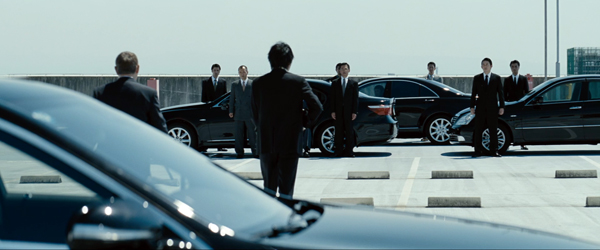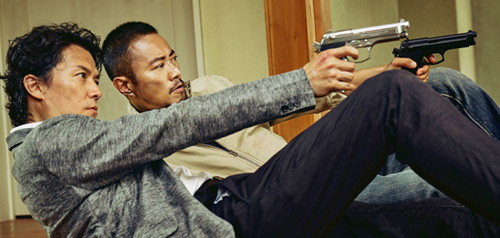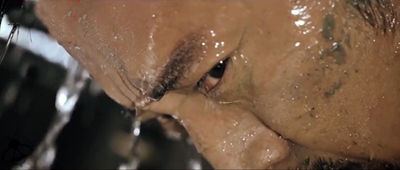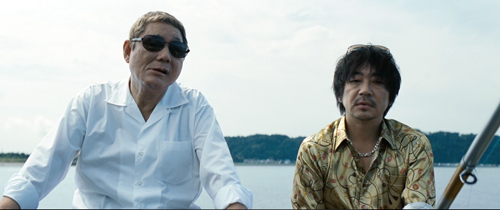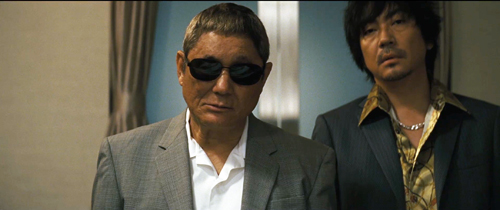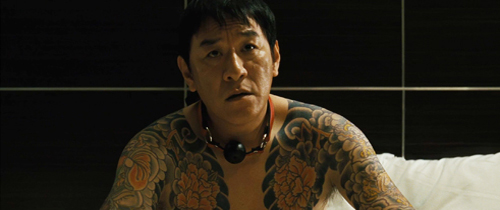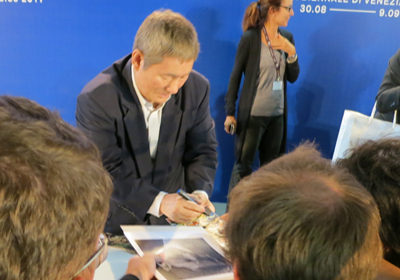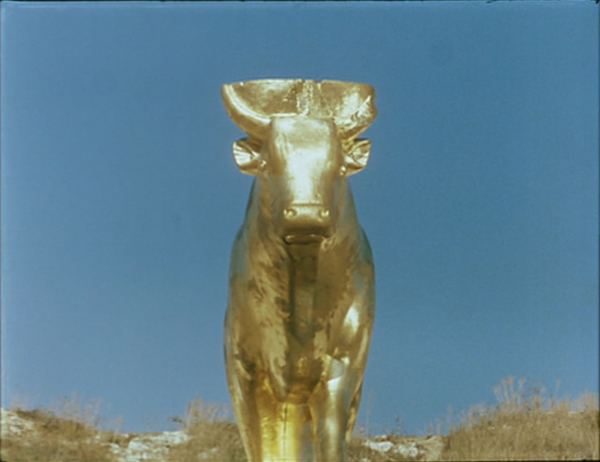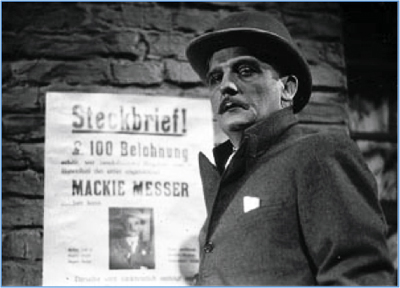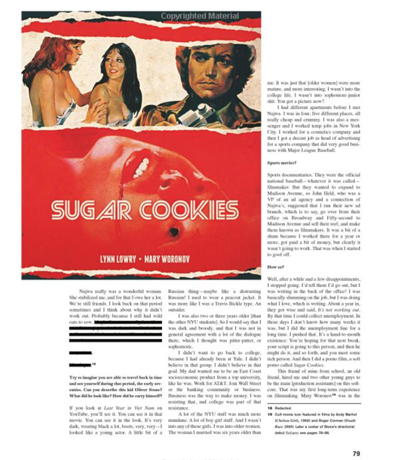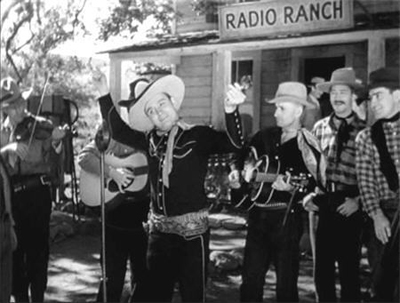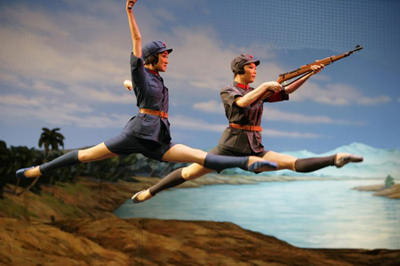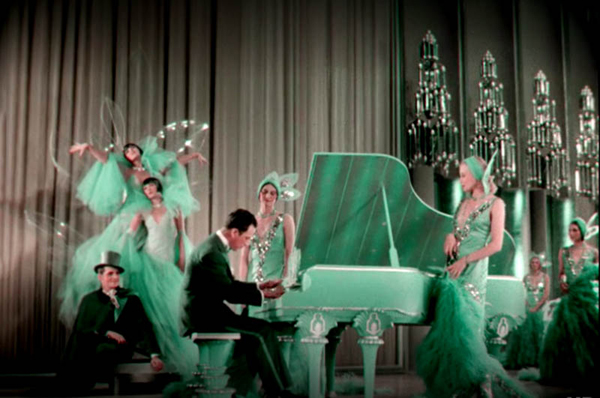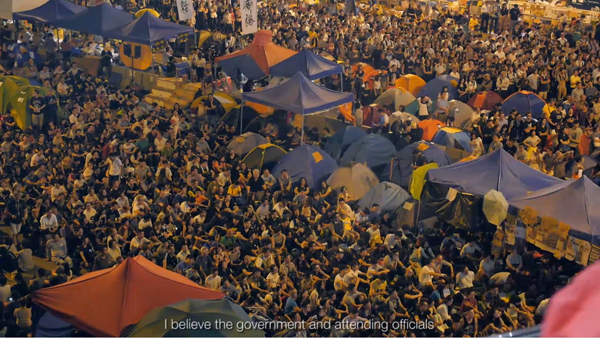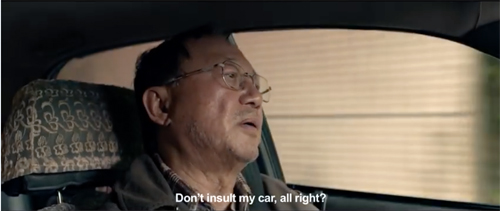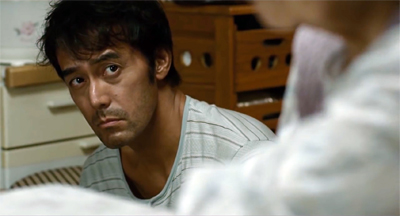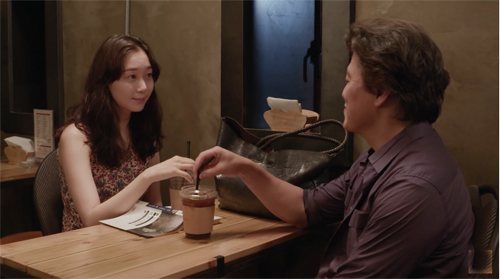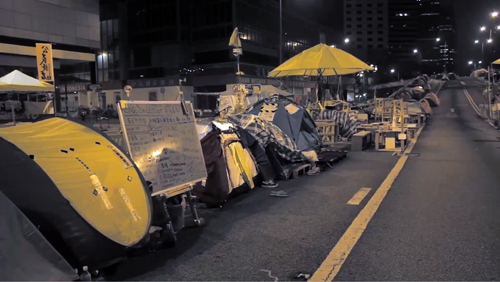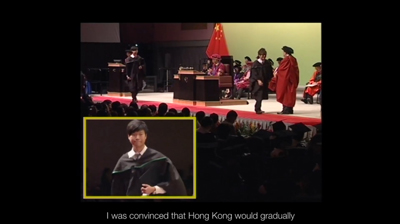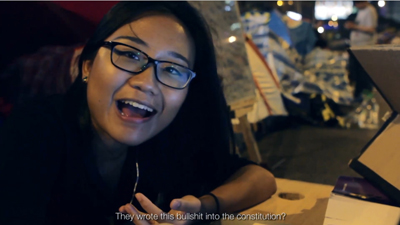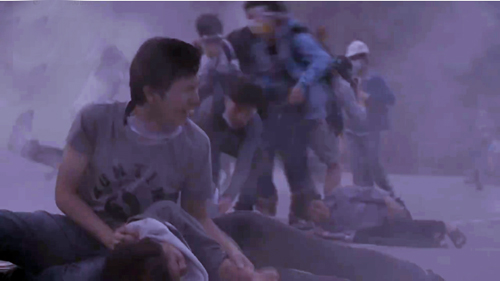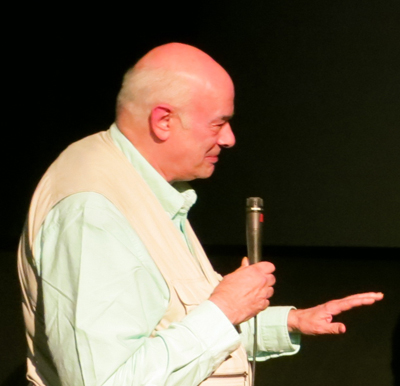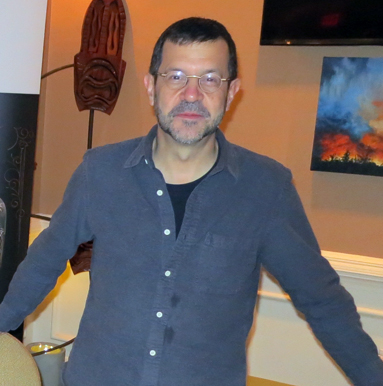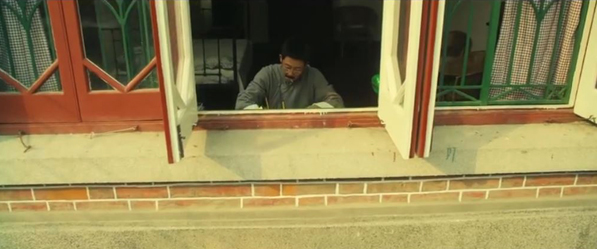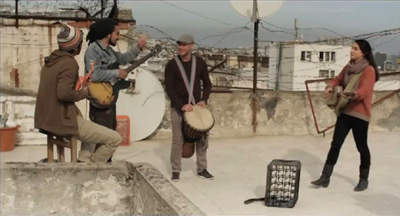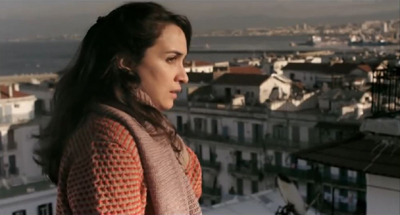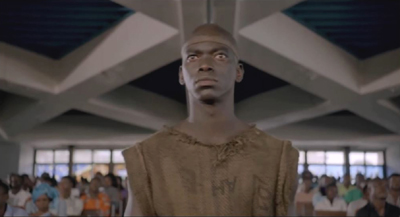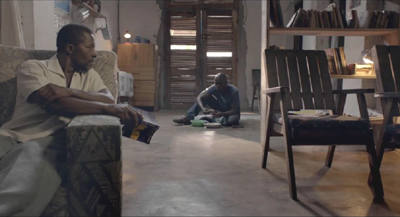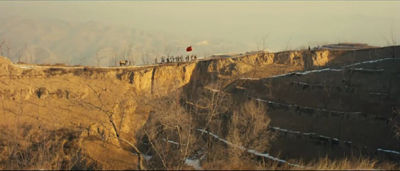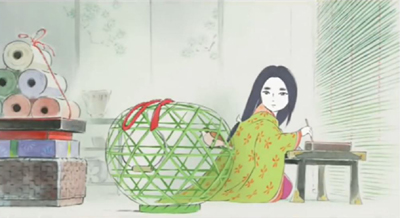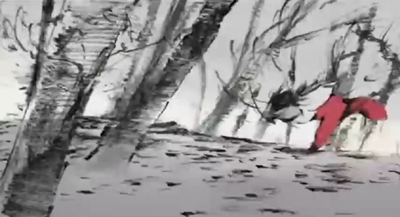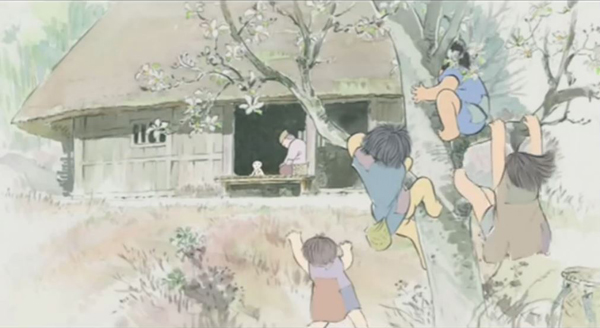Archive for the 'National cinemas: Hong Kong' Category
Venice 2017: Crimes, no misdemeanors
Outrage Coda (2017).
DB here:
The period from 1985-1995 was a sterling era for world cinema. Whatever you think of Hollywood of that time (it wasn’t as bad as they say), American independent film was flourishing then. On the global stage, things were even better, as witness the rising careers of Hou Hsiao-hsien, Edward Yang Dechang, Jackie Chan, Tsui Hark, Abbas Kiarostami, and Wong Kar-wai. It was exhilarating to watch these and other directors turn out splendid work like City of Sadness, A Brighter Summer Day, Police Story, Project A Part II, Peking Opera Blues, Once Upon a Time in China, The Blade, Where Is the Friend’s Home?, Through the Olive Trees, Days of Being Wild, Chungking Express, and more.
That’s not all. In Hong Kong, John Woo was redefining the urban action film with the flamboyant, romantic A Better Tomorrow (1986), The Killer (1989), and Hard-Boiled (1992). In Japan, a standup comedian known as “Beat” Takeshi Kitano took over the helming of a crime thriller, Violent Cop (1989), and decided to continue directing, turning out not only the bored-hitman saga Sonatine (1993) but also the lyrical A Scene at the Sea (1991). Another Japanese filmmaker, Kore-eda Hirokazu, launched his career with the meditative, Hou-ish Maborosi (1995).
I loved these films, and still do. Woo and Kitano belong to an older generation (mine, actually), while Kore-eda is younger. None has gone away. All came to Venice 74 with murder on their minds.
Confessed, but to what?
The Third Murder (2017).
The Third Murder (Sandome no satsujin) is Kore-eda’s first venture into the crime genre, and he brings to it the same steady humanism we find in all his work. I’ve elsewhere recorded my uneasiness with his current visual style. Unlike the grave, long-take Maborosi, his films of the last decade or so are pictorially conventional, even academic, with their big close-ups, needlessly sidling camera moves, and other features of intensified continuity. But he continues to take narrative risks, and his almost Renoirian willingness to see many moral and psychological points of view make every film fairly gripping.
The Third Murder begins abruptly. An unseen victim is bludgeoned and the body is burned. The killer is the man we’ll come to know as Misumi. He’s captured. Like 99% of people charged with crimes in Japan, he readily confesses. His lawyers face only the question of sentencing: Should they try to get him life imprisonment rather than execution? When one attorney, Shigemori, decides to investigate more closely, he peels back layers of uncertainty about the circumstances, the victim, and the motive(s). Like many a victim in crime fiction, this businessman needed killing.
Following conventions of the investigative procedural, the plot relies on secrets, viewpoint shifts that drop hints, twists that frustrate simple understanding, and flashbacks that make us question what we thought we knew. Shooting in anamorphic widescreen, Kore-eda produces some extreme framings reminiscent of Kurosawa’s High and Low, one of the films he studied while preparing the project. Despite occasionally flashy moments, it’s a soberly told tale, emphasizing characterization and social critique. By the end, Misumi acquires a weary, radiant dignity, while entrepreneurial capitalism and the justice system are revealed as compromised. (In this respect it recalls I Just Didn’t Do It, 2007, by another 80s-90s director, Suo Masayuki.) In moving to the sordid terrain of the crime story, The Third Murder shows that Kore-eda hasn’t given up his sympathetic probing of human nature and his praise for un-grandiose self-sacrifice.
Bullets to the head and elsewhere
Manhunt (2017).
Sober and un-grandiose don’t apply to Manhunt (Zhuibu), John Woo’s return to bloody brotherhood and outsize ordnance. After prestige Hollywood efforts like Windtalkers (2002), the nationalistic costume picture Red Cliff (2008-2009), and the ensemble-disaster movie The Crossing (2014-2015), Woo is back with what he does best: showing many people firing many guns, dodging bullets (bad guys have bad aim), diving for cover in slow-motion, floating through hazes of cordite, and instantly recovering from wounds that would finish off you and me. These characters also run endlessly, hop into the path of trains, overturn vehicles, and set loose unconscionable numbers of pigeons.
1990s Hong Kong directors could make cheap pictures look expensive; given bigger budgets, they made expensive pictures look cheap. Here that cheapness shows most in some video-generated shots that recall the bad old days of edge enhancement. But who has time to study such problems when you’re smacked by a fusillade of 3000-plus shots in 105 minutes? Resistance is futile, and the pace doesn’t relent. When the fights and pursuits pause, the dialogue scenes flash by in a flurry of cuts and unfortunate lapses into English. (Much of the soundtrack recalls the eerily dubbed voices on US videos of The Killer.)
You’ve got no time to worry much about all this after an opening that drops us straight into an ambush. Ultra-cool Du Qiu drifts into a bar and quotes yakuza movies before leaving the hostesses to slaughter the gangsters dining there. It does get your attention, and it encourages you to sit through the exposition showing Du as the trusted lawyer for a corrupt pharmaceutical company. He proceeds to be framed for murder and goes on the run. Meanwhile stalwart detective Yamura, charged with bringing Du in, begins to suspect that there’s a bigger scheme afoot. Of course he is right.
This is all completely preposterous and continually enjoyable, with constantly startling action choreography and an overheated soundtrack that at one point breaks into Turandot. Here those damn pigeons don’t just soar into the sky; thanks to CGI, they flap annoyingly into the middle of fight scenes, spoiling a punch or a gunman’s aim. We have, besides our twinned heroes, one corrupt cop, one psychopathic son, one fairly mad scientist, two expert hitwomen (one played by Woo’s daughter), a fleet of black-suited motorcycle assassins, and two docile women who acquire some non-negligible lethality. In the press conference, Woo emphasized his eagerness to create women warriors, and he hasn’t stinted. There are hallucinatory images of a bloody wedding dress to enhance the feminine mystique.
Manhunt is a kind of palimpsest of Asian action movies. It’s a remake of a 1978 Takakura Ken movie released to great popularity in China during the 1980s. Woo, in Hong Kong, had already succumbed to that actor’s spell. What Alain Delon was to The Killer, Takakura is to this, and the steelly self-possession of Zhang Hanyu gives the film a solemnity amid all the flamboyance.
Woo has turned the Japanese original into a real Hong Kong movie, vintage 1992. It lacks the mournful homoeroticism of his prime-period work; these two men don’t gaze moistly at each other, but fire quips and complaints in the Lethal Weapon manner. (The bonding is strongest between the duo of female killers.) Still, it’s very welcome, with its proudly retro air and fanboy in-jokes. It earns the right to begin with a reference to a Japanese classic and conclude with a wink to A Better Tomorrow, as if that movie were the next link in a grand tradition. “Old movies always end this way,” says one of the survivors of the carnage. I wish more new movies did the same.
Hitmen in cars getting shot
Outrage Coda (2017).
Compared to Woo, Kitano is brutally laconic. In Outrage Coda, except for one Wooish slow-mo massacre, violence is brusque, shocking, and over fast. In a film full of bland pans following yakuza cars here and there, the end of one panning movement bursts into shooting before you realize it’s happening, and it ends just as suddenly. Kitano likes his confrontations, for sure, and sometimes there’s a buildup, but mostly the blood just erupts, punctuating long scenes of gangster intrigue.
Here that intrigue involves three rival gangs, each with bosses capable of remarkable lip contortions: the Hanabishi yakuza family, its once-powerful subsidiary the Sanno group, and a gang of fixers operating in Japan and Korea under the auspices of boss Chang. Add in two cops, one ready to knuckle to corrupt superiors, the other raging against them, and you have the world through which Otomo (Kitano) and his sidekick Ichikawa move. Normal life, as it’s commonly known, has no place here.
The action bristles with schemes, shifting alliances, double-crosses, faked deaths, and power grabs.”Your methods,” remarks one boss to a co-conspirator, “are increasingly more intricate.” Remarkably, after an introduction humiliating the not-so-bright Hanaba during a sexcapade, Otomo isn’t seen that much. Two-thirds of the running time are devoted to the machinations of the gangs and the cops. Otomo and Ichikawa swing into action rather late, their task being to chop through the knots of plot and counterplot.
The opening few minutes spread out the key motifs. A fishing scene displaying Kitano’s characteristic love for boyish pastimes is interrupted by the discovery of a pistol. The credits sequence announces the importance of cars with gorgeous shots of Otomo being driven through neon-lit streets, his ride seen from straight down as lights play over it. Throughout, deals are struck or broken in cars, and one memorable execution makes creative use of a Toyota. Even that banal filler, shots of cars pulling up and disgorging their riders, gets played for variations: distant thunder when bosses arrive for a conference, abstract configurations when rival forces meet on a rooftop.
During the 1990s Kitano was one of those directors working with what I’ve called planimetric staging and compass-point editing. (Wes Anderson, Terence Davies, and others worked the same territory.) Characters face the camera in medium shot, and shots change along the lens axis or at 90 degrees to it. It’s as if we were in between the characters. When I asked Kitano about the technique back then, he claimed that it was his effort at realism, capturing how people faced one another in conversation. He added that he didn’t know how to direct a scene, and this was the easiest way.
I thought that his images’ paper-doll simplicity suggested a naivete suited to Kitano’s childish hitmen. Moreover, this rigorous, geometrical technique takes on special impact when presenting mobster shootouts. Instead of ducking for cover as Woo’s heroes do, Kitano’s stand up and keep blasting, firing straight out at the viewer in tit-for-tate exchanges. His unflinching framing, refusing Woo’s camera arabesques, gives these encounters a ceremonial gravity, turning them into rituals of professional righteousness. Last man standing, indeed.
The face-to-face shootouts in Outrage Coda adhere to this style, and early in the film so do the conversations. Here is Otomo discovering Hanada in his masochistic rig.
But for many dialogue scenes Kitano has gone with more orthodox staging and shooting. We get over-the-shoulder shots for conversation, tight close-ups to emphasize character reactions, and even that commonplace of modern cinematography, the arcing movement around a speaker to pick up a listener in the background. These choices allow Kitano to expose the ripe performances of the two conspiratorial dons Nishino (Nishida Toshiyuki) and Nakata (Shiomi Sansei); their leathery skin, slip-sliding jaws, and shouted outbursts gain a lot from this treatment. Not that I’m really complaining. In a slightly longer film than Manhunt, Kitano gives us around 700 shots, less than a quarter of Woo’s outlay. Each image carries a lot of weight.
Outrage Coda concludes a trilogy, and at the press conference Kitano said that he conceived this and Outrage Beyond (2012) as one continuous phase of the story. He wanted the series to finish. The ending of this installment will fuel much speculation about his next move, and he hinted that he might adapt a forthcoming novel, one that’s a love story. He’s done one before in A Scene at the Sea, and arguably in Kikujiro (1999). His fans, who mobbed him at the panel, are certainly ready for whatever he comes up with.
Thanks as ever to all those at the Venice Film Festival who made our stay so enjoyable. Special thanks to Peter Cowie, Alberto Barbera, Michela Nazzarin, Jasna Zoranovich, and our colleagues at the Biennale College Cinema endeavor.
For more on John Woo’s style of action cinema, see my book Planet Hong Kong. I discuss planimetric staging and compass-point editing in On the History of Film Style and several blog entries, notably the persistently popular Shot-consciousness (which has side notes on Kitano) as well as entries on Wes Anderson.
John Woo and Kitano Takeshi satisfy their fans.
Friendly books, books by friends
Moses and Aaron (1974).
DB here:
When the stack of books by friends threatens to topple off my filing cabinet, I know it’s time to flag them for you. I can’t claim to have read every word in them, but (a) we know the authors are trustworthy and scintillating; (b) what I’ve read, I like; (c) the subjects hold immense interest. Then there’s (d): Many are suitable seasonal gifts for the cinephiles in your life (which can include you).
Happy birthday, SMPTE
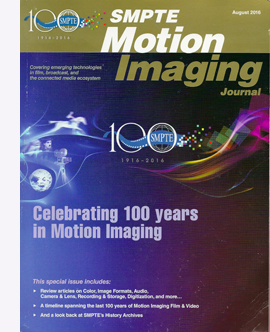 Starting off in 1916 as the Transactions of the Society of Motion Picture Engineers, this peerless record of American moving-image technology has gone through many changes of name and format. It’s now The SMPTE Motion Imaging Journal. Its back issues have been a treasure house for scholars studying the history of movie technology, and it has outdone itself for its 100th Anniversary Issue, published in August.
Starting off in 1916 as the Transactions of the Society of Motion Picture Engineers, this peerless record of American moving-image technology has gone through many changes of name and format. It’s now The SMPTE Motion Imaging Journal. Its back issues have been a treasure house for scholars studying the history of movie technology, and it has outdone itself for its 100th Anniversary Issue, published in August.
It includes survey articles on the history of film formats, cameras and lenses, recording and storage, workflows, displays, archiving, multichannel sound, and television and video. There’s even an overview of closed-captioning. The issue costs $125 for non-SMPTE members, and it’s worth it. Many libraries subscribe to the journal as well.
A highlight is John Belton’s magisterial “The Last 100 Years of Motion Imaging,” which includes twenty-two pages of dense timelines of innovations in film, TV, and video. They stretch back beyond 1916, to 1904 and the transmission of images by telegraph. John’s article is provocative, suggesting that we might think of digital cinema as returning to film’s origins in handmade images for optical toys.
Lucas predicted that digital postproduction brought film closer to painting, and for more and more filmmakers that prediction is coming true. I was startled to learn that 80% of Gone Girl was digitally enhanced after shooting.
Yes, sir, that’s our BB
Die 3 Groschen-Oper (1931, G. W. Pabst).
During the 1970s, Bertolt Brecht’s name was everywhere in film studies. He epitomized what an alternative, oppositional, or subversive cinema ought to be. Cinema, even more powerfully than theatre, was a machine for producing illusions. So in his name critics objected to happy endings, plots that tidied up reality, characters with whom we ought to identify, messages that masked the real nature of bourgeois society. Films made all these things seem part of the natural order of things.
The Brechtian antidote was, as people used to say, to “remind people they were watching a film.” This was done by rejecting what he called the Aristotelian model and replacing it with the “alienation effect”: a panoply of distancing devices like intertitles, characters addressing the camera, actors confessing they were actors, and a display of the means of cinematic production (including shots of the camera shooting the scene).
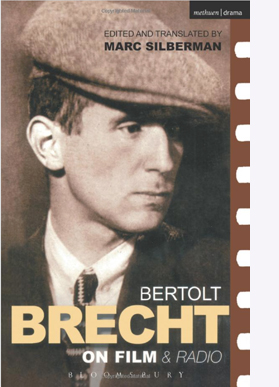 The promise was that once viewers were banished from the imaginary world of the film they would exercise their intellects and coolly appraise not only the fiction machine but its ideological underpinnings. Godard was the chief cinematic surrogate for Brecht, and La Chinoise (1967) became the big prototype of Brechtian cinema—unless you preferred the more austere version incarnated in Straub/Huillet’s Chronicle of Anna Magdalena Bach (1967) and their adaptation of Othon (1969). The ideas spread fast, helped by the user-friendly Brechtianism of Tout va bien (1972).
The promise was that once viewers were banished from the imaginary world of the film they would exercise their intellects and coolly appraise not only the fiction machine but its ideological underpinnings. Godard was the chief cinematic surrogate for Brecht, and La Chinoise (1967) became the big prototype of Brechtian cinema—unless you preferred the more austere version incarnated in Straub/Huillet’s Chronicle of Anna Magdalena Bach (1967) and their adaptation of Othon (1969). The ideas spread fast, helped by the user-friendly Brechtianism of Tout va bien (1972).
Brecht became part of Theory. In French literary and theatrical culture of the 1950s, his ideas on staging and performance had claimed the attention of Roland Barthes and other Parisian intellectuals. Godard was alert to the trend early, it seems; he had fun in Contempt (Le mépris, 1963) citing the two BB’s (the other was Brigitte Bardot, bébé), and letting Lang quote a poem by his old collaborator and antagonist. By the time Anglo-American film theorists were ready for semiotics, Brecht was offering support. Didn’t his anti-illusionism chime well with the belief that all sign systems were arbitrary and culturally relative?
My summary is too simple, but then so were many borrowings. Soon enough any highly artificial cinematic presentation might be called “Brechtian,” though usually minus the politics. In the academic realm, Murray Smith’s book Engaging Characters (1995) pointed out crucial weaknesses in the anti-illusionist, anti-empathy account. By then, the certified techniques were becoming part of mainstream cinema. Thereafter, we had Tarantino’s section titles and plenty of movies breaking the fourth wall. Brecht might have enjoyed the irony of using the to-camera confessions of The Wolf of Wall Street (2013) bent to support cynical swindling. Isn’t The Big Short (2015) a sort of Hollywoodized lehrstück (“learning play”)?
Brecht’s writings should be read and studied by every humanist and certainly everybody interested in film. They’re clear, blunt, and often sarcastic.
This beloved “human interest” of theirs, this How (usually dignified by the word “eternal,” like some indelible dye) applied to the Othellos (my wife belongs to me!), the Hamlets (better sleep on it!), the Macbeths (I’m destined for higher things!), etc.
Now Marc Silberman, our colleague here at Madison, has completed a trio of books that make the master’s work available. Bertolt Brecht on Film and Radio includes essays, scripts, and the Threepenny Opera lawsuit brief. There’s also Brecht on Performance and a complete revision of that trusty black-and-yellow volume dear to many grad students: Brecht on Theatre. The latter two collections Marc worked on with collaborators. All are indispensible to a cinephile’s education. As Brecht imagined a bold political version of music he called misuc; can we imagine a cenima?
From BB to S/H
Speaking of Straub and Huillet, every decade or so somebody comes out with a book about them. This time we have to thank the admirable Ted Fendt, in the twenty-sixth volume in the series sponsored by the Austrian Film Museum (as well as the Goethe Institute and Synema). Like the Hou Hsiao-hsien volume (reviewed here), Jean-Marie Straub & Danièle Huillet is fat and full of ideas and information.
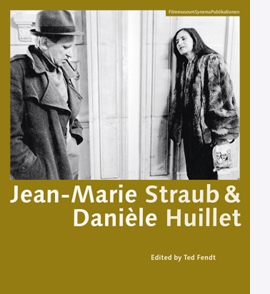 There are interviews, tributes from filmmakers (Gianvito, Farocki, Gorin), and Fendt’s account of distribution and reception of their films in the Anglophone world. This last includes charming facsimile correspondence, with one Huillet letter pockmarked by faulty typewritten o’s. As you’d expect, she is objecting to making a 16mm print of Moses and Aaron (1974) from the 35. (“No, definitively.”)
There are interviews, tributes from filmmakers (Gianvito, Farocki, Gorin), and Fendt’s account of distribution and reception of their films in the Anglophone world. This last includes charming facsimile correspondence, with one Huillet letter pockmarked by faulty typewritten o’s. As you’d expect, she is objecting to making a 16mm print of Moses and Aaron (1974) from the 35. (“No, definitively.”)
Starting things off is a lively and comprehensive survey of the duo’s careers by Claudia Pummer, with welcome emphasis on production circumstances and directorial strategies. The book wraps with a detailed thirty-page filmography and a substantial bibliography.
My thoughts about S/H are tied up with their earliest work, when I first learned of them. So I loved, and still love, Not Reconciled (1965) and The Chronicle of Anna Magdalena Bach. I also have a fondness for Moses and Aaron, Class Relations (1983), From Today until Tomorrow (1996), and Sicilia! (1998). I find others out of my reach, and several others I haven’t yet seen. People I respect find all their work stimulating, so I suspect it’s really a matter of gaps in my taste.
Whether you like them or not, they’re of tremendous historical importance. Without them, Jim Jarmusch and Béla Tarr, and of course Pedro Costa and Lav Diaz, would not have accomplished what they have. And especially in December 2016, we ought to find their unyielding ferocity inspiring. Remember them on Dreyer: “Any society that would not let him make his Jesus film is not worth a frog’s fart.” Brecht would have approved.
Stone’d
To the minimalism of Straub and Huillet we can counterpoint the maximalism of Oliver Stone, the most aggressive tabloid American director since Samuel Fuller (although Rococo-period Tony Scott gives him some competition). After two books on Wes Anderson, Matt Zoller Seitz has brought us a booklike slab as impossible as the man’s films. Can you pick it up? Just barely. Can you read it? Well, probably not on your lap; better have a table nearby. Does its design mirror the maniacal scattershot energy of films like JFK (1991), Natural Born Killers (1994), and U-Turn (1997)? Watch the title propel itself off the cover.
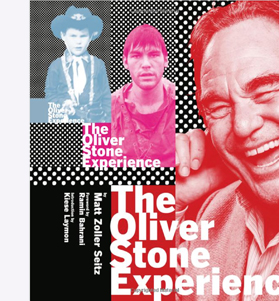 The Oliver Stone Experience is basically a long interview, sandwiched in among luxurious photos, script extracts, correspondence, and the sort of insider memorabilia that Matt has a genius for finding. We get not only pictures of Stone with family and friends, on the set, and relaxing; there are bubblegum cards from the 40s, collages of posters and filming notes, maps, footnotes, and shards of texts slicing in from every which way. Newspapers, ads, and production documents are scissored into the format, including a Bob Dole letter fundraising on the basis of the naughtiness of Natural Born Killers. Beautiful frame enlargements pay homage to the split-diopter framings of Born on the Fourth of July (1989) and the shadow of the 9/11 plane sliding up a facade in World Trade Center (2006). When Stone had second thoughts about things he’d said, Matt had the good idea of redacting the interview like a CIA file scoured with thick black lines.
The Oliver Stone Experience is basically a long interview, sandwiched in among luxurious photos, script extracts, correspondence, and the sort of insider memorabilia that Matt has a genius for finding. We get not only pictures of Stone with family and friends, on the set, and relaxing; there are bubblegum cards from the 40s, collages of posters and filming notes, maps, footnotes, and shards of texts slicing in from every which way. Newspapers, ads, and production documents are scissored into the format, including a Bob Dole letter fundraising on the basis of the naughtiness of Natural Born Killers. Beautiful frame enlargements pay homage to the split-diopter framings of Born on the Fourth of July (1989) and the shadow of the 9/11 plane sliding up a facade in World Trade Center (2006). When Stone had second thoughts about things he’d said, Matt had the good idea of redacting the interview like a CIA file scoured with thick black lines.
The whole thing comes at you in a headlong rush. Amid the pictorial churn and several essays by other deft hands, we plunge into and out of that stellar interview, mixing biography and filmmaking nuts-and-bolts. Matt gets deep into technical matters, such as Stone’s penchant for rough-hewn editing, as well as raising some big ideas about myth and autobiography. There are occasional quarrels between interviewer and interviewee. Out of the blue we get remarks like “Alexander was not only bisexual, he was trisexual,” which was not redacted.
The book’s very excess helps make the case for Stone’s idiosyncratic vision. Matt’s connecting essays, along with the vast visual archive he’s scavenged and mashed up, made me want to rethink my attitude toward this overweening, sometimes crass, sometimes inspired filmmaker. He now seems a quintessential 80s-90s figure, as much a part of the era as Reagan, Bush, and Clinton. Stone emerges as a resourceful defender of The Oliver Stone Experience, articulating a radical political critique with gonzo verve.
Rhapsody in white
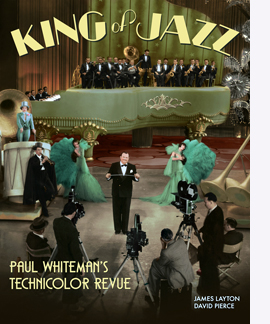 If lifting the Book of Stone doesn’t suffice for exercise, try another weighty and sumptuous item, King of Jazz: Paul Whiteman’s Technicolor Revue, by James Layton and David Pierce. Last spring the Museum of Modern Art premiered one of the most ravishing restorations I’ve ever seen, a digital version of King of Jazz (1930).
If lifting the Book of Stone doesn’t suffice for exercise, try another weighty and sumptuous item, King of Jazz: Paul Whiteman’s Technicolor Revue, by James Layton and David Pierce. Last spring the Museum of Modern Art premiered one of the most ravishing restorations I’ve ever seen, a digital version of King of Jazz (1930).
This period piece is in its own way as wild as an Oliver Stone movie. From its opening cartoon of Paul himself as a Great White Hunter bagging a lion, it’s a virtually self-parodying account of how a black musical tradition got netted, trussed up, and caged for the swaying delectation of white audiences. (No need to mention the irony of the name of our King.)
Along the way we have some straight-up songs (including some by Bing Crosby) spread among extravagant dance numbers. The Universal crane gets a workout as well. The music is infectious, the performers sweating to please, and the restoration–coming, I hope, to your screen soon–finally shows what two-color Technicolor could do. This is the definitive version of a film too often known in cut versions with shabby visuals and sound.
The book is an in-depth contextualization of the film, the studio, and the tradition of musical revues, both on stage and in film. It records the production and reception, with rich documentation throughout. The story of assembling the restoration is there too, and it’s a saga in itself. David is one of the moving spirits behind the online Media History Digital Library and its gateway Lantern. James is Manager of the Celeste Bartos Film Preservation Center at the Museum of Modern Art. Their collaboration has given us both a lush picture book and a serious, always enjoyable piece of scholarship. Their book proves the value of crowdsourcing: funded by online subscription, it was self-published. In this and much else, it can be a model for film historians pursuing questions that commercial and university presses might find too specialized. The result is a model of ambitious research, writing, and publishing.
Visiting Radio Ranch
Gene Autry in The Phantom Empire (1935).
For about thirty years I’ve been arguing that one fruitful research program in film studies involves what I call a poetics of cinema: the study of how, under particular historical conditions, films are made to achieve certain effects. This program coaxes the researcher to analyze form and style, study changing norms of production and reception, and consider how filmmakers work in their institutions and creative communities, with special focus on craft routines, work methods, and tacit theories about the ways to make a movie.
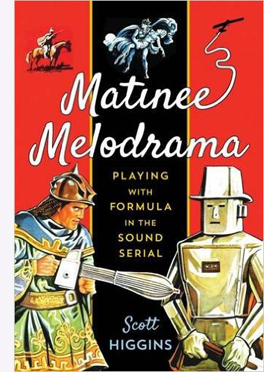 A sturdy example of this approach has appeared from Scott Higgins. His Matinee Melodrama fulfills the promise of its subtitle: Playing with Formula in the Sound Serial. Scott has closely examined this widely despised genre, plunging into the 200 “chapterplays” produced in America between 1930 and 1956. They offer bald and bold display of the rudiments of action-based storytelling: “If Hitchcock built cathedrals of suspense from fine brickwork of intersecting subjectivities and formal manipulations, sound serials used Tinkertoys.”
A sturdy example of this approach has appeared from Scott Higgins. His Matinee Melodrama fulfills the promise of its subtitle: Playing with Formula in the Sound Serial. Scott has closely examined this widely despised genre, plunging into the 200 “chapterplays” produced in America between 1930 and 1956. They offer bald and bold display of the rudiments of action-based storytelling: “If Hitchcock built cathedrals of suspense from fine brickwork of intersecting subjectivities and formal manipulations, sound serials used Tinkertoys.”
Scott traces production practices and conventions, focusing in particular on two dimensions. First, to a surprising degree, serials rely on the conventions of classic stage melodrama, such as coincidence and more or less gratuitous spectacle. Second, the serials are playful, even knowing. Like video games, they invite viewers to imagine preposterous narrative possibilities, not only in the imagination but also on the playground, where kids could mimic what they saw Flash Gordon or Gene Autry do.
Matinee Melodrama investigates the implications of these dimensions for narrative architecture, visual style, and the film and television of our day. Scott closes with analysis of the James Bond series, the self-conscious mimicking of serial conventions in the Indiana Jones blockbusters, and the Bourne saga, and he shows how they amp up the older conventions. “Like the contemporary action film generally, the Bourne movies participate in a cinematic practice vigorously constituted by studio-era serials. That is, they blend melodrama with forceful articulations of physical procedure in scenes of pursuit, entrapment and confrontation.”
Poetics, frank or stealthy
The Red Detachment of Women (1971).
Scott’s book acknowledges the poetics research program, and so, even more explicitly, does a new collection edited by Gary Bettinson and James Udden. The Poetics of Chinese Cinema gathers several essays that usefully test and stretch that frame of reference.
One standard challenge to the poetics approach is: How do you handle social, cultural, and political factors that impinge on film? I think the best way to answer this is to treat these factors as causal influences on a film’s production and reception. More specifically, in the production process, what we now call memes function as materials—subjects, themes, stereotypes, and common ideas circulating in the culture or the filmmaking institution. In the reception process, they provide conceptual structures that viewers can use in making their own sense of the films that they’re given. And such materials will necessarily include other art forms; films are constantly adapting and borrowing from literature, drama, and other media.
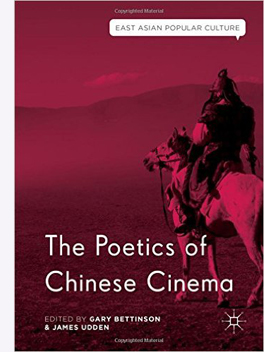 Both of these possibilities are vigorously explored in several essays in The Poetics of Chinese Cinema. For instance, Emilie Yueh-yu Yeh traces how Taiwanese and Japanese cultural materials are reworked by Hou Hsiao-hsien in his Ozu homage Café Lumière (2003). Peter Rist, a long-time student of Chinese painting, shows how Chen Kaige deploys cinematic means to revise landscape traditions to create a “Contemplative Modernism.” Victor Fan shows how the Hong Kong classic In the Face of Demolition (1960) adapts and revises a mode of narration already established in Cantonese theatre. In a clever piece called “Can Poetics Break Bricks?” Song Hwee Lim considers how digital technology feeds into a poetics of spectacle, specifically around slow-motion techniques that were emerging in pre-digital filmmaking.
Both of these possibilities are vigorously explored in several essays in The Poetics of Chinese Cinema. For instance, Emilie Yueh-yu Yeh traces how Taiwanese and Japanese cultural materials are reworked by Hou Hsiao-hsien in his Ozu homage Café Lumière (2003). Peter Rist, a long-time student of Chinese painting, shows how Chen Kaige deploys cinematic means to revise landscape traditions to create a “Contemplative Modernism.” Victor Fan shows how the Hong Kong classic In the Face of Demolition (1960) adapts and revises a mode of narration already established in Cantonese theatre. In a clever piece called “Can Poetics Break Bricks?” Song Hwee Lim considers how digital technology feeds into a poetics of spectacle, specifically around slow-motion techniques that were emerging in pre-digital filmmaking.
Tradition is a key concept in poetics, and the editors explore important ones in their own contributions. Gary Bettinson studies the emergence of Hong Kong puzzle films in works like Mad Detective (2007) and Wu Xia (2011). Are they simple imitation of Hollywood, or are they doing something different? Gary shows them to have complicated ties to local traditions of storytelling. Jim Udden focuses more on stylistics in his account of Fei Mu’s 1948 classic Spring in a Small Town, remade by Tian Zhuangzhuang in 2002. By examining staging, cutting, and voice-over, Jim shows that the earlier film is in many ways more “modern” than it’s usually thought and is somewhat more experimental than the remake.
It might seem that the “model” operas and plays of the Cultural Revolution, epitomized in The Red Detachment of Women (1971) would resist an aesthetic analysis; they’re determined, top-down fashion, by strict canons of political messaging. But Chris Berry’s contribution shows that they’re amenable to close analysis too. Like Soviet Socialist Realism, they may be programmatic in meaning, but not in every choice about framing, performance, cutting, and music. Indeed, the fact that people both inside and outside China (me included) still find them pleasurable probably owes something to their “Red Poetics.” And in true Hong Kong fashion, many filmmakers in that territory plundered those soundtracks with shameless, drop-the-needle panache.
I should probably add that I have an essay in this collection too. It’s called “Five Lessons from Stealth Poetics,” and it surveys things I’ve learned from studying cinema of the “three Chinas”: Hong Kong, Taiwan, and the Mainland. What attracted me were the films themselves, but in exploring them I was obliged to nuance and stretch the poetics approach. Readers of this blog know the trick: in talking about particular movies, I also try to show the virtues of the approach I favor. In other words, stealth poetics.
This is a good moment to pay tribute to Alexander Horwath, moving into his final nine or so months of directing the Austrian Film Museum. He has been a major figure in European film culture, through his inspired programming and leadership in publishing the books and DVDs issued by the Museum. We’re very grateful for all he has done for us and for film historians around the world.
P.S. 11 December 2016: Thanks to Mike Grost for a title correction and John Belton for a name correction!
King of Jazz (1930).
Dragons, tigers, and two programmers
Yellowing (Chan Tze Woon, 2016).
DB here:
It was Asian film that brought me to the Vancouver International Film Festival in 2006, when Tony Rayns asked me to serve on the Dragons and Tigers awards jury. Ever since, Kristin and I have been returning; Tony made VIFF North America’s prime venue for cutting-edge Asian film. Name a major director from the region, and you’ll find that Tony scouted his or her early work for Vancouver.
For some years now, Tony’s co-programmer has been Chinese cinema expert Shelly Kraicer, who has been no less energetic in seeking out exciting new films. You can survey their track record by scanning our VIFF blog entries across the years.
Out of the many films in this year’s D & T retrospective, here are five that I especially admire.
Genres redux
Godspeed.
Across his career, Kore-eda Hirokazu has been a genre pluralist, but in recent years he seems to have settled into the shomin-geki, the bittersweet tale of lower-middle-class life. On the heels of Our Little Sister comes another family dramedy, After the Storm.
Once a prize-winning novelist, Ryota (the lanky, lantern-jawed Abe Hiroshi) is now a racetrack addict and a cheap detective not averse to shaking down high-school kids. After his father dies, and under the jaundiced eyes of his mother, he makes feeble efforts to reunite with his divorced wife and his baseball-playing son.
As usual with Kore-eda, everything flows in simple, unforced fashion, with every shot trimly composed and expertly timed. The emphasis falls on the actors, particularly as they’re captured in mundane activities. Ryota’s mother and sister are first seen writing thank-you notes to people who came to the funeral; he swills in fast food and throws away money on lottery tickets.
Ryota is one of Kore-eda’s most objectionable protagonists. He uses his admittedly minimal surveillance skills to spy on his wife, and he tries to swipe a family scroll to pawn. In an American film, this unlikable loser would pass through an arc that makes him caring, sharing, and on the road to rehab. Instead, as in many Japanese films, the unhappy character relapses into childhood—here, curling up with his son inside a playground octopus during a typhoon. It’s his effort to mimic a bonding moment with his father, but does it succeed now? Kore-eda isn’t betting on it.
Altogether less tranquil is Godspeed, from the Taiwanese director Chung Mong-hung. Chung has given us the horror film Soul (2013), the well-received Fourth Portrait (2010), and the lively Parking (2008), which I reviewed at an earlier VIFF session.
Godspeed is a Tarantinoish excursion into the underworld. It alternates violent scenes of betrayal and reprisals with comic interludes involving a drug courier and the taxi driver he’s hired to carry him to meet the bosses. The film is made with great panache, but for me what makes it noteworthy is that the driver is played by the great Michael Hui, dean of sour Hong Kong social satire.
Hui made his name as a television star before switching to films like The Private Eyes (1976), Security Unlimited (1981), and our favorite, Chicken and Duck Talk (1988). Godspeed revives Hui’s comic persona, the tight-fisted, corner-cutting bargainer who isn’t as clever as he thinks. As Old Xu, he reminisces about Hong Kong traffic and marital woes while trying to wangle a high fare from the phlegmatic, not overbright drug mule. Their misadventures—stumbling into a funeral, being stuffed into a car boot—serve as a counterpoint to the drug war escalating around them. No masterpiece, Godspeed is a beguiling exercise and a welcome return to a legendary and apparently ageless figure of Chinese cinema.
Mysterious, and fun
Another year, another stroll through Hong Sangsoo’s garden of forking paths.
With compositions that are about as banal as they can be, the films don’t aim to dazzle us pictorially. (Nice lighting, though.) The basics are really basic: Straight-on angles, fixed long take two-shots, simple come-and-go pans, an occasional and inexplicable zoom. These are his tools.
Dialogue and performance drive the action, which consists mostly of chance encounters and conversations in cafés, bars, restaurants, and bedrooms. His characters are students, artists, and film directors (usually fairly pretentious ones). Romantic hookups emerge, only to dissolve or play themselves out in parallel worlds, the whole presented in a “stacked” arrangement of modular scenes.
These scenic blocks display an obsessive, almost never mechanical, recourse to split viewpoints, recursive time schemes, mirror inversions, and whimsically varied replays. I’ve argued earlier that these permutations often test our faulty memory for exactly what transpired in a scene many minutes before, but it should be noted that sometimes, as in the last stretch of Oki’s Movie (2010), he’ll set the variations side by side.
Or maybe just side by side in your head. If the auteur theory didn’t exist, it would have to be invented to account for the effect of Yourself and Yours. In any other movie, when a man recognizes a young woman in a café, and she says he’s mistaken her for her twin, we might be inclined to take it as a brush-off. In a Hong movie, the scene makes us think back through all his other plots that have relied on doubling. So maybe this time he’s found a new variation? Has he got an actual pair of twins who will circulate through the scenes, constantly being taken for one another?
Suffice it to say that the young woman (women?), repeatedly encountering three men who are attracted to her (them?), becomes (become?) the pretext for the usual Hong mockery of male vanity and insecurity. The lackadaisical painter Youngsoo is worried about his girlfriend Minjung, who drinks more than he’d like. Moreover, his friend reports that she’s been seen with other men. Quickly enough, we spot her sharing drinks with an older man and a film director—who discover that they are old classmates. “This is mysterious,” the director remarks, “and fun.” None of the would-be Romeos notice that the lady in question is reading Kafka’s The Metamorphosis.
Hong always has another card up his sleeve, and Yourself and Yours, while not as ingenious as his previous entry Right Now, Wrong Then (2015), is satisfyingly teasing. It also yields one of the most flagrantly self-indulgent trailers I know: faithful to the movie, but frustrating in just the right ways.
Taking it to the streets
When college students en masse join a movement for social change, their positions tend to be vindicated in the long run. In the United States, students were right to support movements against nuclear proliferation, against racial discrimination, against American involvement in Vietnam, for women’s liberation and LGBT rights, against the invasion of Iraq, and, right here in Wisconsin, against Republican union-busting and voter suppression. The same pattern can be observed around the world, in student protests in Europe, South America, and Asia. Elders deride students as naïve, but more often than not, student activists critical of the status quo get principled politics right.
Why? I suspect several causes, including the fact that many (not all) students are reading, thinking, and learning while the general populace trudges through the dull compulsion of everyday labor. College flings together students from many backgrounds and may open eyes about how other people live. (Right-wingers worry too much about liberal professors indoctrinating students. In my experience, students are more influenced by their peers than by the likes of me.) And of course the flexible scheduling of college days allows motivated students the time to engage in political action.
Whatever the causes, it’s no surprise that in Hong Kong, the street protests running from September through December of 2014 were launched by young people. In August the mainland’s Communist Party decreed that instead of direct election of the territory’s Chief Executive, candidates would be chosen by a nominating committee comprised of businessmen and politicians sympathetic to Beijing. In effect, this guaranteed a puppet leader of the type all too familiar in the territory. Students responded by organizing actions similar to the Occupy movement in America. With surprising speed, civil disobedience and sit-down occupation spread through downtown areas of Hong Kong Island and the Kowloon Peninsula.
Hong Kongers were long considered indifferent to politics, only concerned with scrambling to get ahead and make money. But the world had to notice when tens of thousands of students and ordinary men and women built vast encampments in the streets in front of chic shops and noodle restaurants. Wearing yellow ribbons and hard-hats, and armed with umbrellas to protect them against sun, rain, and tear gas, they were apparently ready for a long stay.
This epochal event in Hong Kong history is documented in Yellowing, a new film by Chan Tse Woon. It was made under the auspices of Ying e chi, a filmmaking collective that has been working since the propitious year 1997, when the British turned the territory over to the People’s Republic. Although framed as a diary, it’s basically a cinéma vérité account of moments and vignettes of the Umbrella Revolution. The voice-over narration is keenly personal, beginning with home-movie footage of Chan’s childhood and youth, interrupted by his memory of repeated promises that democracy would soon arrive.
Loosely organized, Yellowing offers no systematic chronology of events à la a PBS program. It’s defiantly local, a snapshot album for Hong Kongers who will recognize each phase of the movement. At the start, some gorgeous nighttime cityscapes are shattered by confrontations with police (“Police, retreat,” the students chant) and conversations with student organizers in their down time. In the two hours that follow, we spend a lot of that time with young people like the ceaselessly beaming Rachel, who’s now considering becoming a civil rights lawyer. We see one boy passing out wristbands reading, They can’t kill us all.
Students set up tents, squat in pounding rain, organize English classes, and run supply chains across the vast areas of occupation. There are clashes with police and civilians. (“Your flesh and blood belongs to your family,” a man charges.) Chan’s camera captures, helter-skelter, assaults from cops and street gangs. There are camera duels, with police filming demonstrators while demonstrators film police. Chan’s voice-over says that he thought his camera would protect him, but he still gets punched in the face. The occupiers practice tactical evasion and passive resistance, but there’s no effort to heroicize them. Many are crying as police lead them away.
Despite the almost casual presentation, you realize how much these kids are risking. Many are poor, some are trying to hang onto a job, and nearly all realize that this will change their lives. “Even if we lose this fight, we’ll lose together.” As for the angry citizens wearing blue ribbons declaring support for authorities, the students are sympathetic: “Don’t you think they need democracy too?”
The film circles back to the opening, with Daddy-cam shots of children. We hear Rachel writing in reply to a professor who had urged the students to give way for the sake of “security,” and to stop being tools of “foreign subversion.” The film lingers on her cheerful, polite suggestion that Mainland domination has replaced British colonialism, and that the children of the future deserve better.
Most of our politicians and all of our plutocrats will never know the sort of courage that these young people displayed with modest, good-humored tenacity. Unarmed—unlike the Y’all Queda fraidycats who occupied our Oregon wildlife refuge—these unprepossessing kids stood a very good chance of being brutalized by a government not known for recognizing the niceties of due process. You feel proud of the young people of Hong Kong while watching this heartbreaking, hopeful film. As often happens, the students were both righteous and right.
Not hope, fear
Ying e chi has often worked with theatres to show independent films, but Yellowing has been denied a theatrical release. Instead, Variety reports, producer Vincent Chui has arranged for guerrilla screenings. Five ticketed shows were held at the Hong Kong Film Archive, in order to qualify for this year’s Hong Kong Film Awards.
The resistance to Yellowing doubtless owes a lot to the controversy surrounding another film, Ten Years (2015). It won astonishing success in local theatres. According to Maggie Lee in Variety, it cost only US$65,000 but earned nearly $800,000 before Beijing realized how subversive it was and blasted it as a “thought virus.” Ten Years was nominated for a Hong Kong Film Award, which made the PRC cancel television coverage of the ceremony. When the film won the Best Picture prize, shock waves went through the film community, and it was denounced by producers and executives. It was soon cast out of theatres, but screenings continued in community centers, churches, and outdoor venues. It’s slated for a DVD release soon.
Ten Years consists of five shorts linked by the premise of local life in 2025. In its dystopian portrayal of Mainland domination of Hong Kong, it’s a fairly direct outgrowth of the Umbrella Revolution. But if Yellowing documents the movement’s hope, this film exposes, as many commentators have noted, fear.
One episode, “Extras,” dramatizes behind-the-scenes scenes political machinations as a sort of noir comedy. Two hapless thugs are hired to stage an assassination attempt that will arouse public support for a new security law. While the men rehearse their gun choreography, the puppeteers debate whether killing or wounding the targets would play better in the media.
Other episodes are more concerned with the cultural impact of Beijing’s dominance of local life. “Season of the End” presents scientists searching rubble for signs of now-vanished Hong Kong life, shot in ominously clinical detail. “Dialect” presumes that Mandarin is becoming the official language of the territory, and we see a taxi driver struggling to cast off his Cantonese. “Local Egg” also centers on language. Here a shopkeeper is forbidden to use the word “local” because it suggests those political factions struggling to keep Hong Kong distinct, or maybe pushing it to become independent. In an echo of the Cultural Revolution, this episode shows schoolkids in uniform arriving with iPads to check shops’ compliance with the list of forbidden words and retail items.
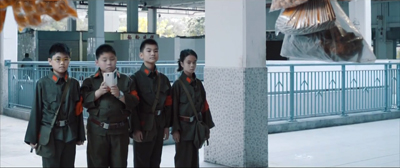
The most emotionally wrenching episode, “Self-Immolator,” is a pseudo-documentary. Startling scorch-marks on the sidewalk are the traces of someone who burned to death in protest of government oppression. Through talking heads, a collage of demonstration footage, and some investigation, the film traces how a young man’s hunger strike led to the mysterious self-immolation. Several candidates for the self-sacrifice are canvassed before, in a break with the documentary frame, the protest suicide is shown. In the conclusion, an umbrella is seen aflame, perhaps forming a requiem for the 2014 protests.
Ten Years is a good example of how a film can have social importance because of the moment at which it emerges. Along with Yellowing, it will be a lasting memorial to the struggles of Hong Kong people to introduce democracy to China.
Thanks to Tony and Shelly for all their work in setting up these screenings. In addition, Kristin and I are grateful to Alan Franey, PoChu AuYeung, and Jennie Lee Craig and their colleagues for making our VIFF visit so enjoyable and enlightening. Special thanks to Tallulah for cheerfulness and Lillooet for the waffles.
Thanks to our regular attendance at VIFF, we’ve discussed many of Hong Sangsoo’s films; see the director category.
The development of the Umbrella Revolution is traced in this long New York Times story. Last August, accused student leaders got surprisingly light sentences. Some of the “localists” and Occupiers won places in the Legco elections and are expected to make waves.
Tony Rayns and Shelly Kraicer.
The World comes to Vancouver
The Golden Era.
Kristin here:
One of the great pleasures of the Vancouver International Film Festival is the ability it provides for a quick trip around the world, especially to countries whose films are seldom seen in a non-festival setting.
In one day I was able to see an Algerian film and one from the Ivory Coast. It struck me that both of them reflected how far digital filmmaking has come in small producing countries. When digital cameras came on the scene, they were hailed as a way for people in nations with little or no filmmaking infrastructure to create movies. The results, fascinating though they might be, often betrayed visually the fact that they were made with non-professional cameras.
Perhaps we have reached a new stage in digital filmmaking in such countries. Both the Algerian film, The Rooftops (Merzak Allouache, 2013), and the Ivory Coast one, Run (Philippe Lacôte, 2014), have a polish and complexity of form and style that put them on a level with those made in larger, more established national cinemas.
The Rooftops provides a model of how to make a film with a limited budget and avoid conventionality. Allouache chose to set the film entirely on the rooftops of five districts of Algiers. It’s a gimmick of sorts, and yet it carries practical advantages. No sets had to be built, and few, if any scenes required artificial light. Presumably no streets had to be cleared, since no action is staged at ground-level.
Beyond that, each scene could be played out with the city of Algiers providing a backdrop, as when a group of young musicians practice on one of the rooftops:
With backgrounds like that, who needs sets?
The film has a strict formal logic, both spatially and temporally. It begins by introducing five rooftops, each with its own set of characters. There’s no crossover among the groups. None of them ever meet, so this isn’t what David has termed a network narrative. But the look of each rooftop is different, and simply by keeping the characters in one limited area, the filmmakers help us keep track of them fairly easily as the narrative moves among storylines.
The film starts with the first call to prayer in the darkness before dawn, and at intervals the four other calls follow (with a subtitle providing information on the name of each call and the time period within which the respective prayers are supposed to be performed.) These essentially act as chapter breaks, giving a sense of time passing. The five prayers also echo the five rooftops.
There’s no shortage of drama in each group’s story. On a lower floor of an unfinished building a mob boss has a man tortured, trying to force him to sign something. This disturbs a group of filmmakers taking shots from the roof above, with dire consequences. A landlord is murdered on another rooftop, and a suicide occurs on yet another. One gets a cumulative impression of crime and conflict being rife across these various districts of Algiers.
Allouache is considered the preeminent Algierian director, and the violence and strife depicted rather melodramatically are part of his ongoing critique of his nation’s social problems.
In contrast, Lacôte sets Run apart by adopting a classic flashback structure. The film opens with the crisis of the story: the hero, nicknamed “Run,” shoots the prime minister in a crowded auditorium and flees.
From then on, we see him in hiding as he reflects on how he became an assassin. The alternation of scenes from his youth and his current-day attempts to avoid capture are easily comprehensible. Lacôste finds ways to create visual interest and avoid conventional stagings of scenes, as in the low angle above that juxtaposes the hero with a looming, crisscrossing ceiling.
Another example comes when his friend gives him shelter and food. Rather than a simple shot/reverse-shot conversation across a table, we see a depth scene, with Run sitting on the floor to eat and his friend in the foreground twisting to talk with him:
Back in the 1960s and 1970s, the notion was that people in underdeveloped countries could gain small cameras and discover their own ways of making films, free of Hollywood conventions. To some extent that happened. But with the globilization of mass media, few people, however isolated, can remain unaware of Western culture.
Presumably some filmmakers have aspired to match the technical standards of Western offerings in international film festivals. These two films show them succeeding, having thoroughly grasped the conventions of both art films and popular genres. We ‘ll discuss an example of the latter in an upcoming entry on Middle-eastern films at VIFF, and in particular the Iranian vampire film, Girl Walks Home Alone at Night.
Ann Hui’s quiet epic
Ann Hui’s career is usually associated with intimate films, mostly studies of character. We saw her at Ebertfest earlier this year, where she presented A Simple Life, the epitome of such films.
Now she has surprised audiences with another character study, but one set in a tumultuous period of Chinese history, the late 1930s and early 1940s. The Golden Era (2014) tells the story of female writer Xiao Hong, who died young in 1942. Not all the facts of Xiao Hong’s life are known, and the narrative sketches scenes derived from the author’s own writings. Interspersed are “documentary” shots of interviews with people (played by actors) who knew and worked with Xiao Hong.
Much of the tale consists of small-scale scenes, conversations among a few people set indoors or in the streets. Yet as the Japanese invasion begins and spreads, occasional big scenes occur, and Hui proves herself perfectly capable of suggesting creating a sense of epic events.
The war is only fleetingly present, however. We see it mainly from the viewpoint of the main characters, as when a quiet indoor conversation scenes are abruptly and startlingly cut short by bombs going off outside and shattering windows.
The film’s settings and costumes create a vivid sense of the era. There are street scenes in Hong Kong shortly before its fall to the Japanese that appear almost documentary in their realism. Throughout the images are beautiful, as the frame at the top of the entry demonstrates.
The film’s three-hour running length adds to the epic feel, tracing the heroine’s changing fortunes across momentous historical events. It makes a striking contrast with A Simple Life, and yet Hui’s concern with precision and detail in delineating characters remains constant. The pair might bring her back to the sort of prominence outside Hong Kong that she enjoyed in the 1980s and early 1990s. Indeed, The Golden Era was just presented as the gala film at the Busan Film Festival.
Another farewell from a Ghibli master
Just over a year ago Miyazaki Hayao announced that he would retire, having completed and released his final film, The Wind Rises (2013). Speculation over the fate of Studio Ghibli, the animation studio that he co-founded, followed.
Now we have the reported final film of a second of the three original founders, Takahata Isao, whose most famous film is Grave of the Fireflies (1988). Like The Wind Rises, The Tale of the Princess Kaguya (2014) lets its director go out on a high note.
Based on a tenth-century fairy tale, Princess Kaguya has a distinctive style, with most scenes done in translucent watercolors in pastel shades, quite different from the solid, vivid colors of much of Miyazaki’s work. It tells its story in a leisurely fashion, running 137 minutes, which may be a bit challenging for younger children, but it is never boring.
Kaguya is not necessarily a princess. We’re not sure what she is. She appears miraculously one day as a tiny baby in a glowing bamboo shoot. She is iscovered by a bamboo-cutter who assumes she is a princess and insists on calling her that. The bamboo-cutter and his wife raise her in a forest cottage (seen below). The opening section is idyllic, with the tiny girl growing unnaturally fast, in spurts. She is befriended by neighboring children, and the group explores the surrounding countryside, reveling in the beauty of the plants and animals they observe there.
Spurred by another miraculous discovery, this time of gold nuggets inside a bamboo stalk, the bamboo-cutter decides to build a mansion in a nearby city and make Naguya into a real princess by marrying her off to royalty. There ensues the classic competition among suitors to find the most fabulous object and present it to Naguya.
Naturally Naguya longs for the countryside and finally rebels. In a remarkably stylized, exciting scene that contrasts with the rest of the film, she races toward her forest home, and the pastel settings disappear. She becomes a blur of black, white, and red flashing through a gloomy landscape with sketchily drawn trees and plants that flicker wildly past:
The Tale of Princess Taguya has been announced for an October 17 release in the USA, distributed by GKids. Unfortunately it will only be available in a dubbed version. Even dubbed, it’s worth seeing on the big screen, but with luck there will be an option for the original Japanese-language version with subtitles on the DVD/BD release.
Studio Ghibli has released another film, The Kingdom of Dreams and Madness, a documentary about the studio by Sunada Mami. (It played at Toronto but is not here at VIFF.) Its appearance seems to hint that Ghibli really is going to cease feature production, though the official story is that it is only pausing. It has been a prolific producer of short animated films, and perhaps that side of its activities will continue. For a good summary of the situation and a description of the documentary, see here.
The Tale of Princess Taguya












